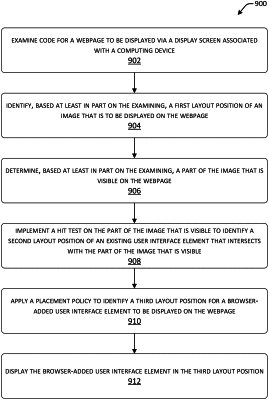| CPC G06F 3/0481 (2013.01) [G06F 3/0484 (2013.01); G06F 9/451 (2018.02); G06F 16/9577 (2019.01); G06F 40/106 (2020.01); G06F 40/143 (2020.01); G06F 2203/04804 (2013.01)] | 20 Claims |

|
1. A method implemented by a browser operating on a computing device, comprising:
examining code for a webpage to be displayed via a display screen associated with the computing device;
identifying, based at least in part on the examining, a first layout position of an image that is to be displayed on the webpage;
determining, based at least in part on the examining, a rectangle that encloses a part of the image that is visible on the webpage;
implementing a hit test on the rectangle to identify a second layout position of an existing user interface element that is placed on the part of the image that is visible on the webpage, wherein the existing user interface element is part of the webpage;
applying a placement policy to identify a third layout position for a browser-added user interface element to be displayed on the webpage, wherein:
the third layout position is within the rectangle that encloses the part of the image that is visible and the third layout position avoids overlapping the second layout position of the existing user interface element; and
the placement policy allows for consistent placement of the browser-added user interface element across a plurality of images;
determining when a user-controlled pointer element hovers over the rectangle that encloses the part of the image that is visible on the webpage; and
displaying the browser-added user interface element in the third layout position when the user-controlled pointer element hovers over the rectangle that encloses the part of the image that is visible on the webpage.
|